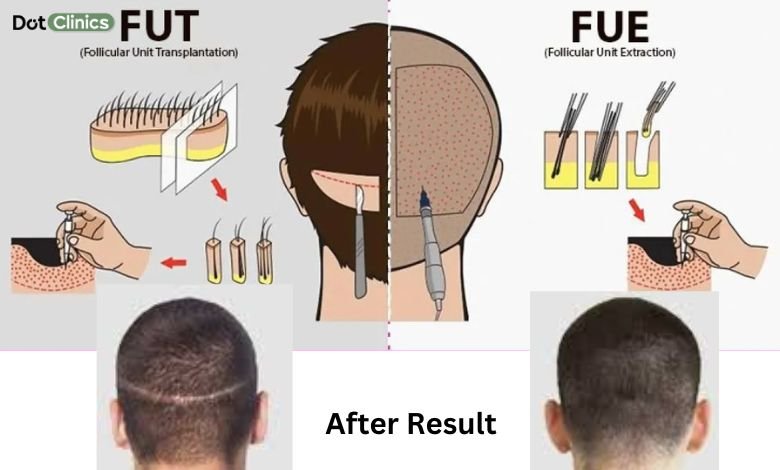Learn the major differences between FUE and FUT hair transplant, including costs, benefits, procedures, and success rates, and select the right one for yourself.
FUE vs FUT hair transplant: Which one is best for you?
Many people face a widespread issue of hair loss which has a negative impact on their confidence as well as on their self-worth. But many procedures are available now to give people a good appearance. Hair transplants are one of them and have the most effective two techniques known as Follicular Unit Extraction (FUE) and Follicular Unit Transplantation (FUT). Both treatments help to regrow hair but their process, effectiveness and suitability is different. You can learn about their differences in this guide to make informed decisions for yourself.
What is hair transplant?
Hair transplant is a clinical method or invasive procedure created to regain hair growth in those areas which are influenced by baldness and thinning. Hair follicles are retrieved from one part of the body, usually from the back of the scalp and transplanted to hair loss areas. This technique provides a permanent solution to people facing hair loss issues.
Types of hair transplant
There are many types of hair transplant but these two are mostly used.
- FUE
- FUT
Follicular Unit Extraction (FUE)
FUE is an advanced and surgical hair transplant method in which individual hair follicles are extracted from the donor part and implanted to the bald or thinning area known as recipient site. Stripping of skin is not required in this method, as a result it leads to faster recovery and minimal scarring.
Who is best fit for FUE?
- People who want short hairstyles without any visible scars.
- Those who prefer minor surgical procedures with quick healing.
- People who seek natural-looking results and have mild to moderate hair loss.
- Individuals who look for a procedure that enables the retrieval of body hair if required.
Who should avoid FUE?
- People who have less donor hair might not go for this procedure as they won’t get desired coverage.
- People with extensive hair loss may need numerous sessions which ultimately make the treatment time consuming.
- People with medical problems should avoid this procedure as it can slow the healing process and might enhance the chances of risk and complications.
Pros of FUE
- People who prefer to keep short hair can idealize this procedure as there is no linear scarring.
- People choosing this can heal instantly within 7-10 days.
- This procedure gives natural looking outcomes because of accurate follicle positioning.
- It is appropriate for body hair transplantation in the condition of restricted scalp donor strands.
Cons of FUE
- FUE causes mild inflammation and redness in the treated area.
- Discomfort, numbness and irritation at the donor and recipient site can be a possible side effect.
- If the surgeon is not experienced then the risk of follicle damage can occur.
Procedure of FUE
- The donor area is shaved, rinsed and then prepared for the extraction of follicles.
- Hair follicles are retrieved by using a micro-punch tool.
- On the recipient site, small incisions are made where the follicles are transplanted.
- To formulate a natural looking hairline the extracted hair follicles are strategically placed.
- The post treatment care instructions are given to the patient to make sure the proper growth and recovery.
Cost of FUE
FUE is more expensive than FUT as it takes time and advanced technology is used in this procedure. The price range for this hair transplant is RS 70000 to RS 110,000, based on the number of grafts needed and the expertise of the clinic.
How successful is FUE?
The success rate of FUE is high with 90-95% grafts growing and surviving successfully. It is one of the most reliable and efficient methods.
Follicular Unit Transplantation (FUT)
FUT is also called the strip method. In this method, strips of the skin are removed from the donor part, mostly from the back of the head. These strips are then carefully dissected into the individual follicular units which are implanted into the recipient sites.
Who should get FUT?
- People who need large amounts of grafts and face significant hair loss can prefer this hair transplant technique.
- This method is beneficial for people who want an affordable cure with high sustainability rates of grafts.
- People who are not bothered by getting a linear scar in the donor part can also choose this hair transplant method.
Who should avoid FUT?
- People who don’t want to show the scar and keep very short hair should not go for this method.
- People who are sensitive to keloid scarring or have slow wound healing processes are also not best fit for this procedure.
- People who want instant recovery should avoid FUT technique.
Pros of FUT
- In this method, more grafts can be implanted in a single session which make it ideal for extensive hair loss.
- The survival rate of grafts in this method is higher than FUE.
- It is the best choice for budget conscious people as it is affordable.
Cons of FUT
- FUT takes time to heal as compared to FUE which usually recovers in 2-3 weeks.
- Due to removal of skin, numbness and tightness might be felt in the donor area but that is temporary.
- If hair is cut short then a linear scar will be visible at the donor site.
Procedure of FUT
- Anaesthesia is used to numb the donor site.
- A strip of scalp is surgically extracted and the area is stitched.
- The strip is divided into separate follicular units under a microscope.
- To accommodate the transplanted follicles, tiny cuts are made in the recipient side.
- The retrieved or extracted follicles are implanted and post treatment care instructions are given to the patient.
Cost of Fut
FUT is less expensive and cost effective as compared to FUE. It ranges from RS 50000 to RS 200,000, depending on the clinic and number of grafts needed.
How successful is FUT?
The survival rate of graft is 95-98% in FUT which makes it the most effective hair regrowth method.
If a person needs maximum hair volume and doesn’t bother a scar then FUT is the best fit for him. But if you prefer instant healing, less scarring and a natural look then you might choose FUE. Proper consultation with a skilled hair transplant surgeon is necessary to identify the ideal method for your specific needs.
FAQs
- Which method leaves visible scars after hair transplant?
In the FUE method, the scars are tiny and unnoticeable but in the FUT method, a linear scar can be seen if the hair is short.
- Is shock loss permanent?
Shock loss is a situation in which temporary shedding of transplanted or surrounding hair occurs due to any trauma but this is not permanent and hair regrows within a few months.
- Should I use hair growth products after a transplant?
When the recovery process is finished, then growth products can be used which can boost results but don’t use anything without a doctor’s prescription.
- Is hair transplant also for a woman?
Women who are facing the problems of hair loss, thinning and bald spots can get a hair transplant but before getting it an advice from a specialist is mandatory.
- Are the results of hair transplant permanent?
Surrounding hair may get thin with the passage of time but the transplanted hair is permanent as it is extracted from a genetically resistant area.
- Can a natural look appear after hair transplant?
The outcomes of hair transplant give a natural look because the transplanted hair grows like normal hair.


